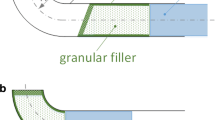Abstract
Wrinkling is the key forming defect in thin-wall tube bending process, when the wall thickness-to-diameter ratio is smaller than 0.01. The granular media-based thin-wall elbow push-bending process involves filling a tube with spherical particles and pushing the tube into a die to bend a tubular blank into an elbow shape. If the wall thickness of tube is smaller than the particle size, wrinkling significantly depends on micro contact force distribution in granular media, and the granular media cannot be approximately simulated by FEM. In the present paper, an elbow tube with 0.3 mm wall thickness, 30 mm outer diameter, and 90 mm bending radius is formed by granular media-based push-bending process. The wrinkling is investigated; especially, the micro contact force distribution at the initial buckling location is observed based on a 3D FEM-DEM coupling model. In the coupling model, FEM is used to simulate bending deformation of tubular blank, and DEM is used to simulate micro contact forces of particle flow. Finally, a simplified formulation is proposed for predicting wrinkling of thin-wall elbow tube in granular media-based push-bending process and validated by experiment of an elbow tube with 0.7 mm wall thickness, 70 mm outer diameter, and 105 mm bending radius.
Graphical abstract
















Similar content being viewed by others
Data availability
The data sets supporting the results of this article are included within the article.
References
Yang H, Li H, Zhang ZY et al (2012) Advances and trends on tube bending forming technologies. Chin J Aeronaut 25:1–12
Hashmi MSJ (2006) Aspects of tube and pipe manufacturing processes: meter to nanometer diameter. J Mater Process Technol 179:5–10
Yang H, Li H, Zhang ZY et al (2012) Advances and trends on tube bending forming technologies. J Plast Eng 8:83–85
Vasilikis D, Karamanos SA (2012) Mechanical behavior and wrinkling of lined pipes. Int J Solids Struct 49:3432–3446
Abela JM, Gardner L (2012) Elastic buckling of elliptical tubes subjected to generalized linearly varying stress distributions. Thin-Walled Struct 58:40–50
Nia AA, Nejad KF, Badnava H et al (2012) Effects of buckling initiators on mechanical behavior of thin-walled square tubes subjected to oblique loading. Thin-Walled Struct 59:87–96
Teng BG, Hu L, Liu G et al (2012) Wrinkling behavior of hydro bending of carbon steel Al alloy bilayered tubes. Trans Nonferrous Metals Soc China 22:560–565
Zeng Y, Li Z (2002) Experimental research on the tube push-bending process. J Mater Process Technol 122:237–240
Baudin S, Ray P, Mac Donald BJ et al (2004) Development of a novel method of tube bending using finite element simulation. J Mater Process Technol 153:128–133
Kahnamouei JT, Behjat B (2010) Modeling and experimental validation of the effect of sand filling on avoiding wrinkling phenomenon in thin-walled tube bending process. In: ASME 2010 10th Biennial Conference on Engineering Systems Design and Analysis. American Society of Mechanical Engineers, pp 799–803
Grüner M, Merklein M (2010) Numerical simulation of hydro forming at elevated temperatures with granular material used as media compared to the real part geometry. Int J Mater Form 3:279–282
Chen H, Güner A, Khalifa NB, Tekkaya AE (2016) Granular media-based tube press hardening. J Mater Process Technol 228:145–159
Chen H, Hess S, Haeberle J, Pitikaris S, Born P, Güner A, Sperl M, Tekkaya AE (2016) Enhanced granular medium-based tube and hollow profile press hardening. CIRP Ann Manuf Technol 65:273–276
Dong GJ, Zhao CC, Peng YX et al (2015) Hot granules medium pressure forming process of AA7075 conical parts. Chin J Mech Eng 28:580–591
Dong GJ, Bi J, Du B et al (2017) Research on AA6061 tubular components prepared by combined technology of heat treatment and internal high pressure forming. J Mater Process Technol 242:126–138
Du B, Zhao CC, Dong GJ et al (2017) FEM-DEM coupling analysis for solid granule medium forming new technology. J Mater Process Technol 249:108–117
Liu H, Zhang SH, Song HW, Shi GL, Cheng M (2019) 3D FEM-DEM coupling analysis for granular-media-based thin-wall elbow tube push-bending process. Int J Mater Form 12:985–994
H.D. Hibbit,B.I. Karlsson, P. Sorensen. 2007, Theory Manual, ABAQUS, Version 6.7, Providence, RI, USA
Tsuji Y, Tanaka T, Ishida T (1992) Lagrangian numerical-simulation of plug flow of cohesionless particles in a horizontal pipe. Powder Technol 71:239–250
Christofferson J, Mehrabadi MM, Nemat-Nassar S (1981) A micromechanical description on granular material behavior. ASME: J Appl Mechan 48:339–344
Rothenburg L, Selvadurai APS (1981) Micromechanical definitions of the Cauchy stress tensor for particular media. In: Selvadurai APS (ed) Mechanics of Structured Media. Elsevier, Amsterdam, pp 469–486
Timoshenko S, Gere JM (1961) Theory of Elastic Stability, Second edn. McGraw Hill, New York, NY
Funding
The present work is funded by the project of Suzhou Key Laboratory Foundation (SZS201815).
Author information
Authors and Affiliations
Contributions
The persons making contributions on this work have been listed in author information.
Corresponding authors
Ethics declarations
Ethical approval
Neither the entire paper nor any part of its content has been published or has been accepted elsewhere. It is not being submitted to any other journal.
Consent to participate
The authors consent to participate in this work.
Consent for publication
The authors consent to publish this paper on “The International Journal of Advanced Manufacturing Technology”.
Competing interests
The authors declare no competing interests.
Additional information
Publisher’s note
Springer Nature remains neutral with regard to jurisdictional claims in published maps and institutional affiliations.
Rights and permissions
About this article
Cite this article
Liu, H., Zhang, SH., Ding, YP. et al. A simplified formulation for predicting wrinkling of thin-wall elbow tube in granular media–based push-bending process. Int J Adv Manuf Technol 115, 541–549 (2021). https://doi.org/10.1007/s00170-021-07168-2
Received:
Accepted:
Published:
Issue Date:
DOI: https://doi.org/10.1007/s00170-021-07168-2




